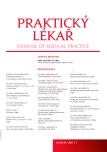The motivation of a patient to treatment and preventive measures
Authors:
R. Ptáček 1; J. Raboch 1; L. Domkářová 1; V. Bencko 2
Authors‘ workplace:
Psychiatrická klinika 1. LF UK a VFN, Praha
Přednosta: prof. MUDr. Jiří Raboch, DrSc.
1; Ústav hygieny a epidemiologie 1. LF UK a VFN, Praha
Přednosta: prof. MUDr. Milan Tuček, CSc.
2
Published in:
Prakt. Lék. 2017; 97(1): 17-22
Category:
Of different specialties
Overview
The article gives a summary of the issue of motivation of the patient to treatment and preventive measures. In this context factors that operate in this field are analyzed. We also provide an overview of commonly used terms, that are being used in this context in domestic and foreign literature. Separately, we discuss the issue of the perception of risk and the possibility of effective preventive measures to protect the health of the public space.
Keywords:
motivation for treatment – compliance – preventive measures
Sources
1. Vermeire E, Hearnshaw H, Van Royen P, Denekens J. Patient adherence to treatment: three decades of research. A comprehensive review. J Clin Pharm Ther 2001; 26: 331–342.
2. Jániš M. Kompliance (část I) – Historie problematiky, definice. Psychosom 2012; 10: 16–25.
3. Jániš M. Kompliance I (část II) – Zjišťování, důsledky. Psychosom 2012; 10: 111–120.
4. Jániš M. Kompliance (část III) – Teoretické modely. Psychosom 2012; 10: 166–175
5. Jániš M. Kompliance (část IV) – Faktory, které ji ovlivňují. Psychosom 2012; 10: 282–296.
6. Jániš M. Kompliance (část V) – Povaha vztahu mezi pacientem a zdravotníkem jako faktor ovlivňující komplianci. Psychosom 2013; 11: 33–44.
7. Jániš M. Kompliance (část VI) – Postupy, které ji zvyšují. Psychosom 2013; 11: 82–92.
8. Jániš M. Kompliance (část VII) – Etické otázky v tématu kompliance. Psychosom 2013; 11: 169–175.
9. Čéšková E. Kompliance v psychiatrii. Čas. Lék. čes. 2009; 148: 489–492.
10. Di Matteo MR, Di Nicola DD. Achieving patient compliance: The psychology of the medici practiitioners role. New York: Pergamon Press 1982.
11. Urquhart J. Patient non-compliance with drug regimens: measurement, clinical correlates, economic impact. Eur Heart J 1996; 17(Suppl A): 8–15.
12. Sackett DL. Introduction. In: Haynes B, Taylor DW, Sackett DL (eds.) Compliance in health care. Baltimore: The John Hopkins University Press 1979; 1–7.
13. Simpson JA, Weiner ESC. The Oxford English Dictionary. Oxford: Oxford University Press 1989.
14. Dracup KA, Meleis AI. Compliance: an interactionist approach. Nurs Res 1982; 31: 31–36.
15. van Dulmen S, Sluijs E, van Dijk L, et al. Patient adherence to medical treatment: a review of reviews. BMC health serv res 2007; 7: 55.
16. Sabate E. Adherence to long-term therapies: Evidence for action. Geneva: World Health Organization 2003.
17. Vander Stichele R. Measurement of patient compliance and the interpretation of randomized clinical trials. Eur J Clin Pharmacol 1991; 41: 27–35.
18. Grifith S. A review of the factors associated with compliance and the taking of prescribed medicines. Br J Gen Pract 1990; 40: 114–116.
19. Morris LS, Schulz RM. Patient compliance: an overview. J Clin Pharm Ther 1992; 17: 183–195.
20. Zolnierek KBH, DiMatteo MR. Physician communication and patient adherence to treatment: a meta-analysis. Med care 2009; 47: 826.
21. Roberson MHB. The meaning of compliance: patient perspectives. Qual Health Res 1992; 2: 7–22.
22. Donovan JL. Patient decision making. The missing ingredient in compliance research. Int J Technol Assess Health Care 1995; 11: 443–455.
23. King NJ, Peck CL. Enhancing patient compliance with medical regimens. Aust Fam Physician 1981; 10: 954–960.
24. Bencko V, Honzák R. Význam psychosociálních faktorů pro racionální management zdravotních rizik v prostředí. Prakt. Lék. 1997: 77(8): 379–381.
25. Godsmith JR. Epidemiological studies of radio-frequency radiation: Current status and areas of concern. The Sci of the Total Environ, 1996; 180(1): 3–8.
26. Klener V, Bencko V. Černobyl 1986. In: Bencko V, a kol. Hygiena. Praha: Karolinum 2000; 169–175.
27. Aldous JC, Ellam GA, Murray V, et al. An outbreak of illness among schoolchildren in London: Toxic poisoning not mass hysteria. J Epidemiol Community Health 1994; 48(1): 41–45.
28. Ali-combe A, Guthrie E, McDermott N. Mass hysteria: One syndrome or two? Brit J Psychiat 1966; 186(5): 633–635.
29. Klein DF. False suffocation alarms, spontaneous panics, and related conditions: An integrated hypothesisi. Arch Gen Psychiat 1993; 50(4): 306–317.
30. Drábková J, Bencko V. Percepce rizika, chaos a agresivní panika – psychosomatické a psychosociální aspekty i ničivost. Anesteziologie, resuscitace a intenzivní medicína 2016; 63(1 Suppl): 45–54.
31. Bencko V, Quinn J. Health risk assessment and its perception in environmental settings: Psychosomatic and psychosocial aspects. Cetr Euro J of Occup and Environ Medicine 2016; 22(1–2): 77–82.
Labels
General practitioner for children and adolescents General practitioner for adultsArticle was published in
General Practitioner

2017 Issue 1
Most read in this issue
- Paracetamol poisoning
- Risk factors of falls in hospitalized patients
- Multiple chemical sensitivity
- Duties of attending physician in assessing the health status for the purposes of disability, social security benefits and employment
